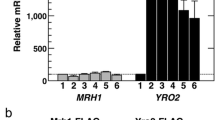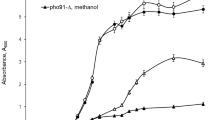Abstract
In fungi, two recognized mechanisms contribute to pH homeostasis: the plasma membrane proton-pumping ATPase that exports excess protons and the vacuolar proton-pumping ATPase (V-ATPase) that mediates vacuolar proton uptake. Here, we report that overexpression of PEP3 which encodes a component of the HOPS and CORVET complexes involved in vacuolar biogenesis, shortened lag phase in Saccharomyces cerevisiae exposed to acetic acid stress. By confocal microscopy, PEP3-overexpressing cells stained with the vacuolar membrane-specific dye, FM4-64 had more fragmented vacuoles than the wild-type control. The stained overexpression mutant was also found to exhibit about 3.6-fold more FM4-64 fluorescence than the wild-type control as determined by flow cytometry. While the vacuolar pH of the wild-type strain grown in the presence of 80 mM acetic acid was significantly higher than in the absence of added acid, no significant difference was observed in vacuolar pH of the overexpression strain grown either in the presence or absence of 80 mM acetic acid. Based on an indirect growth assay, the PEP3-overexpression strain exhibited higher V-ATPase activity. We hypothesize that PEP3 overexpression provides protection from acid stress by increasing vacuolar surface area and V-ATPase activity and, hence, proton-sequestering capacity.






Similar content being viewed by others
References
Ali R, Brett CL, Mukherjee S, Rao R (2004) Inhibition of sodium/proton exchange by a Rab-GTPase-activating protein regulates endosomal traffic in yeast. J Biol Chem 279:4498–4506
Arlt H, Perz A, Ungermann C (2011) An overexpression screen in Saccharomyces cerevisiae identifies novel genes that affect endocytic protein trafficking. Traffic 12:1592–1603
Bauer BE, Rossington D, Mollapour M, Mamnun Y, Kuchler K, Piper PW (2003) Weak organic acid stress inhibits aromatic amino acid uptake by yeast, causing a strong influence of amino acid auxotrophies on the phenotypes of membrane transporter mutants Eur. J Biochem 270:3189–3195
Balderhaar HJ, Ungermann C (2013) CORVET and HOPS tethering complexes–coordinators of endosome and lysosome fusion. J Cell Sci 126:1307–1316
Bradford MM (1976) A rapid and sensitive method for the quantitation of microgram quantities of protein utilizing the principle of protein-dye binding. Anal Biochem 72:248–254
Coonrod EM, Graham LA, Carpp LN, Carr TM, Stirrat L, Bowers K, Stevens TH (2013) Homotypic vacuole fusion in yeast requires organelle acidification and not the V-ATPase membrane domain. Dev Cell 27:462–468
Diakov TT, Tarsio M, Kane PM (2013) Measurement of vacuolar and cytosolic pH in vivo in yeast cell suspensions. J Vis Exp 74, e50261. doi:10.3791/50261
Ding J, Bierma J, Smith MR, Poliner E, Wolfe C, Hadduck AN, Bakalinsky AT (2013) Acetic acid inhibits nutrient uptake in Saccharomyces cerevisiae: auxotrophy confounds the use of yeast deletion libraries for strain improvement. Appl Microbiol Biotechnol 97:7405–7416
Eraso P, Gancedo C (1987) Activation of yeast plasma membrane ATPase by acid pH during growth. FEBS Lett 224:187–192
Gietz RD, Schiestl RH, Willems AR, Woods RA (1995) Studies on the transformation of intact yeast cells by the LiAc/SS-DNA/PEG procedure. Yeast 11:355–360
Harding TM, Morano KA, Scott SV, Klionsky DJ (1995) Isolation and characterization of yeast mutants in the cytoplasm to vacuole protein targeting pathway. J Cell Biol 131:591–602
Hönscher C, Mari M, Auffarth K, Bohnert M, Griffith J, Geerts W, van der Laan M, Cabrera M, Reggiori F, Ungermann C (2014) Cellular metabolism regulates contact sites between vacuoles and mitochondria. Dev Cell 30:86–94
Hueso G, Aparicio-Sanchis R, Montesinos C, Lorenz S, Murguía JR, Serrano R (2012) A novel role for protein kinase Gcn2 in yeast tolerance to intracellular acid stress. Biochem J 441:255–264
Hughes AL, Gottschling DE (2012) An early age increase in vacuolar pH limits mitochondrial function and lifespan in yeast. Nature 492:261–265
Jones GM, Stalker J, Humphray S, West A, Cox T, Rogers J, Prelich G (2008) A systematic library for comprehensive overexpression screens in Saccharomyces cerevisiae. Nat Methods 5:239–241
Kawahata M, Masaki K, Fujii T, Lefuji H (2006) Yeast genes involved in response to lactic acid and acetic acid: acidic conditions caused by the organic acids in Saccharomyces cerevisiae cultures induce expression of intracellular metal metabolism genes regulated by Aft1p. FEMS Yeast Res 6:924–936
Kellermayer R, Aiello DP, Miseta A, Bedwell DM (2003) Extracellular Ca2+ sensing contributes to excess Ca2+ accumulation and vacuolar fragmentation in a pmr1∆ mutant of S. cerevisiae. J Cell Sci 116:1637–1646
Lawrence CL, Botting CH, Antrobus R, Coote PJ (2004) Evidence of a new role for the high-osmolarity glycerol mitogen-activated protein kinase pathway in yeast: regulating adaptation to citric acid stress. Mol Cell Biol 24:3307–3323
Li SC, Kane PM (2009) The yeast lysosome-like vacuole: endpoint and crossroads. Biochim Biophys Acta 1793:650–663
Martínez-Muñoz GA, Kane PM (2008) Vacuolar and plasma membrane proton pumps collaborate to achieve cytosolic pH homeostasis in yeast. J Biol Chem 283:20309–20319
Michaillat L, Baars TL, Mayer A (2012) Cell-free reconstitution of vacuole membrane fragmentation reveals regulation of vacuole size and number by TORC1. Mol Biol Cell 23:881–895
Mira NP, Teixeira MC, Sá-Correia I (2010) Adaptive response and tolerance to weak acids in Saccharomyces cerevisiae: a genome-wide view. OMICS 14:525–540
Mollapour M, Piper PW (2007) Hog1 mitogen-activated protein kinase phosphorylation targets the yeast Fps1 aquaglyceroporin for endocytosis, thereby rendering cells resistant to acetic acid. Mol Cell Biol 27:6446–6456
Nakamura N, Hirata A, Ohsumi Y, Wada Y (1997) Vam2/Vps41p and Vam6/Vps39p are components of a protein complex on the vacuolar membranes and involved in the vacuolar assembly in the yeast Saccharomyces cerevisiae. J Biol Chem 272:11344–11349
Nelson H, Nelson N (1990) Disruption of genes encoding subunits of yeast vacuolar H(+)-ATPase causes conditional lethality. Proc Natl Acad Sci 87:3503–3507
Nichols BJ, Ungermann C, Pelham HR, Wickner WT, Haas A (1997) Homotypic vacuolar fusion mediated by t- and v-SNAREs. Nature 387:199–202
Ohya Y, Umemoto N, Tanida I, Ohta A, Iida H, Anraku Y (1991) Calcium-sensitive cls mutants of Saccharomyces cerevisiae showing a Pet− phenotype are ascribable to defects of vacuolar membrane H+-ATPase activity. J Biol Chem 266:13971–13977
Padilla-López S, Pearce DA (2006) Saccharomyces cerevisiae lacking Btn1p modulate vacuolar ATPase activity to regulate pH imbalance in the vacuole. J Biol Chem 281:10273–10280
Palmqvist E, Hahn-Hägerdal B (2000) Fermentation of lignocellulosic hydrolysates. I: inhibition and detoxification. Bioresour Technol 74:17–24
Papp B, Pál C, Hurst LD (2003) Dosage sensitivity and the evolution of gene families in yeast. Nature 424:194–197
Peplowska K, Markgraf DF, Ostrowicz CW, Bange G, Ungermann C (2007) The CORVET tethering complex interacts with the yeast Rab5 homolog Vps21 and is involved in endo-lysosomal biogenesis. Dev Cell 1:739–750
Pfaffl MW (2001) A new mathematical model for relative quantification in real-time RT-PCR. Nucleic Acids Res 29:e45
Plant PJ, Manolson MF, Grinstein S, Demaurex N (1999) Alternative mechanisms of vacuolar acidification in H+-ATPase-deficient yeast. J Biol Chem 274:37270–37279
Preston RA, Murphy RF, Jones EW (1989) Assay of vacuolar pH in yeast and identification of acidification-defective mutants. Proc Natl Acad Sci 86:7027–7031
Price A, Seals D, Wickner W, Ungermann C (2000) The docking stage of yeast vacuole fusion requires the transfer of proteins from a Cis-snare complex to a Rab/Ypt protein. J Cell Biol 148:1231–1238
Schauer A, Knauer H, Ruckenstuhl C, Fussi H, Durchschlag M, Potocnik U, Fröhlich KU (2009) Vacuolar functions determine the mode of cell death. Biochim Biophys Acta 1793:540–545
Schumacher K, Krebs M (2010) The V-ATPase: small cargo, large effects. Curr Opin Plant Biol 13:724–730
Smith MR, Boenzli MG, Hindagolla V, Ding J, Miller JM, Hutchison JE, Bakalinsky AT (2013) Identification of gold nanoparticle-resistant mutants of Saccharomyces cerevisiae suggests a role for respiratory metabolism in mediating toxicity. Appl Environ Microbiol 79:728–733
Sobanski MA, Dickinson JR (1995) A simple method for the direct extraction of plasmid DNA from yeast. Biotechnol Tech 9:225–230
Suzuki T, Sugiyama M, Wakazono K, Kaneko Y, Harashima S (2012) Lactic-acid stress causes vacuolar fragmentation and impairs intracellular amino-acid homeostasis in Saccharomyces cerevisiae. J Biosci Bioeng 113:421–430
Swinnen S, Fernández Niño M, González-Ramos D, van Maris AJA, Nevoigt E (2014) The fraction of cells that resume growth after acetic acid addition is a strain-dependent parameter of acetic acid tolerance in Saccharomyces cerevisiae. FEMS Yeast Res 14:642–653
Tal R, Winter G, Ecker N, Klionsky DJ, Abeliovich H (2007) Aup1p, a yeast mitochondrial protein phosphatase homolog, is required for efficient stationary phase mitophagy and cell survival. J Biol Chem 282:5617–5624
Van Dyke N, Baby J, Van Dyke MW (2006) STM1p, a ribosome-associated protein, is important for protein synthesis in Saccharomyces cerevisiae under nutritional stress conditions. J Mol Biol 358:1023–1031
Van Dyke N, Chanchorn E, Van Dyke MW (2013) The Saccharomyces cerevisiae protein STM1p facilitates ribosome preservation during quiesence. Biochem Biophys Res Commun 430:745–750
Weisman LS (2003) Yeast vacuole inheritance and dynamics. Annu Rev Genet 37:435–460
Wickner W (2010) Membrane fusion: five lipids, four SNAREs, three chaperones, two nucleotides, and a Rab, all dancing in a ring on yeast vacuoles. Annu Rev Cell Dev Biol 26:115–136
Xu X, Wightman JD, Geller BL, Avram D, Bakalinsky AT (1994) Isolation and characterization of sulfite mutants of Saccharomyces cerevisiae. Curr Genet 25:488–496
Zieger M, Mayer A (2012) Yeast vacuoles fragment in an asymmetrical two-phase process with distinct protein requirements. Mol Biol Cell 23:3438–3449
Acknowledgments
We thank Severino Zara for help in screening the overexpression library; Van Anh Vu for technical assistance; Brett Tyler and Viviana Perez for help with western blotting; Tom Stevens, Patricia Kane, and Christian Ungermann for helpful discussions; and Jennifer Lorang for providing FM4-64. This work was supported in part by grant no. 2010-65504-0345 from the United States Department of Agriculture National Institute of Food and Agriculture (USDA-NIFA) program to A.T.B. and M.H.P. and from the United States National Institutes of Health (NIH) grant no. R15GM104876 to J.P.-V. The flow cytometry analysis was performed in the Cell Image and Analysis Facilities Core of the Oregon State University Environmental Health Sciences Center supported in part by grant no. P30ES000210-42 from the National Institute of Environmental Health Sciences (NIEHS), United States National Institutes of Health.
Conflict of interest
None.
Author information
Authors and Affiliations
Corresponding author
Electronic supplementary material
Below is the link to the electronic supplementary material.
ESM 1
(PDF 895 kb)
Rights and permissions
About this article
Cite this article
Ding, J., Holzwarth, G., Bradford, C.S. et al. PEP3 overexpression shortens lag phase but does not alter growth rate in Saccharomyces cerevisiae exposed to acetic acid stress. Appl Microbiol Biotechnol 99, 8667–8680 (2015). https://doi.org/10.1007/s00253-015-6708-9
Received:
Revised:
Accepted:
Published:
Issue Date:
DOI: https://doi.org/10.1007/s00253-015-6708-9




